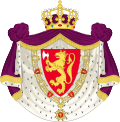Schleswig-Holstein-Sonderburg-Glücksburg
| Den här artikeln behöver källhänvisningar för att kunna verifieras. (2012-09) Åtgärda genom att lägga till pålitliga källor (gärna som fotnoter). Uppgifter utan källhänvisning kan ifrågasättas och tas bort utan att det behöver diskuteras på diskussionssidan. |

Schleswig-Holstein-Sonderburg-Glücksburg är ett europeiskt furstehus med en äldre och en yngre gren som härstammar från Huset Oldenburg. Den yngre grenen regerar eller har regerat i flera europeiska furstehus.
Schleswig-Holstein-Sonderburg-Glücksburg (äldre gren)
Den äldre grenen av Schleswig-Holstein-Sonderburg-Glücksburg grundades av hertig Philipp von Schleswig-Holstein-Sonderburg-Glücksburg (född 15 mars 1584, död 27 september 1663). Han var son till hertig Hans d.y. av Sönderborg vilken i sin tur var tredje son till kung Kristian III av Danmark som var sonsonson till den tyske greven Didrik den lycklige (död 1440) av Oldenburg. Tillnamnet Glücksburg kommer av stamsätet som var slottet i Glücksburg. Från hertig Philipp härstammade följande hertigar i rakt nedstigande led (namn och regeringsperiod):
- Christian, 1663–1698
- Philipp Ernst, 1698–1729
- Friedrich, 1729–1766
- Friedrich Heinrich Wilhelm, 1766–1779
Med Friedrich Heinrich Wilhelm utgick den äldre grenen på svärdssidan.
Schleswig-Holstein-Sonderburg-Glücksburg (yngre gren)
Hertig Fredrik Wilhelm av Schleswig-Holstein-Sonderburg-Beck erhöll 1825 av kung Fredrik VI av Danmark titeln hertig av Schleswig-Holstein-Sonderburg-Glücksburg. Han fick också slottet Glücksburg som stamsäte och därav kallas ofta huset kort Huset Glücksburg. Från denna yngre gren av huset Schleswig-Holstein-Sonderburg-Glücksburg stammar:
Hertigar av Schleswig-Holstein-Sonderburg-Glücksburg
Namn och regeringsperiod:
- Karl, 1831–1863,
- Fredrik (Friedrich), 1863–1885,
- Fredrik Ferdinand, 1885–1918,
varefter huset detroniserades och hertig Fredrik (Friedrich) Ferdinand blev huvudman för grenen:
- Friedrich Ferdinand, 1918-1934,
- Friedrich, hertig av Schleswig-Holstein 1934–1965,
- Peter, hertig av Schleswig-Holstein 1965–1980,
- Christoph, prins av Schleswig-Holstein 1980-2023,
- Friedrich Ferdinand av Schleswig-Holstein 2023-
Regenter i Danmark (från 1863)
Från hertig Fredrik Wilhelms fjärde son, sedermera Kristian IX stammar det danska kungahuset.
Regenter i Grekland (1863-1974)

Från Kristian IX:s andre son stammar det numera detroniserade grekiska kungahuset:
Namn och regeringsperiod:
- Georg I, 1863–1913
- Konstantin I, 1913–1917 och 1920–1922
- Alexander I, 1917–1920
- Georg II, 1922–1924 och 1935–1947
- Paul I, 1947–1964
- Konstantin II, 1964–1974
Regenter i Norge (från 1905)

- Kung Haakon VII av Norge (1872–1957, regerade 1905–1957)[1]
- Kung Olav V av Norge (1903–1991, regerade 1957–1991)[1]
- Kung Harald V av Norge (född 1937, har regerat sedan 1991)[1]
Regenter i Storbritannien (från 2022)
- Charles III (född 1948), regerar sedan 2022
Andra medlemmar av huset Schleswig-Holstein-Sonderburg-Glücksburg
Huset har förgreningar i de flesta av Europas kungahus där några personer kan nämnas
- Prins Philip, hertig av Edinburgh, barnbarn till kung Georg I av Grekland.
- Prins Michael av Grekland, barnbarn till kung Georg I av Grekland.
- Drottning Sophia av Spanien vars farfars far också var kung Georg I av Grekland.
På mödernet härstammar kung Albert II av Belgien och storhertig Henri av Luxemburg från Kristian IX av Danmark.
Källor
Externa länkar
 Wikimedia Commons har media som rör Schleswig-Holstein-Sonderburg-Glücksburg.
Wikimedia Commons har media som rör Schleswig-Holstein-Sonderburg-Glücksburg.
Kungahus, översikt
Media som används på denna webbplats
Författare/Upphovsman: Tkgd2007, Licens: CC BY-SA 3.0
A new incarnation of Image:Question_book-3.svg, which was uploaded by user AzaToth. This file is available on the English version of Wikipedia under the filename en:Image:Question book-new.svg
Författare/Upphovsman: Jacques63, Licens: CC BY-SA 3.0
Coat of arms of Duché Schleswig-Holstein-Sondebourg-Glücksbourg
Författare/Upphovsman: Di (they-them), Licens: CC BY-SA 4.0
Royal arms of Denmark from 2024, based on information from https://www.kongehuset.dk/en/the-monarchy-in-denmark/the-royal-symbols/the-royal-coat-of-arms/# (image).
Författare/Upphovsman:
- Royal Coat of Arms of Greece.svg: Sodacan
- derivative work: Sodacan (talk)
Coat of arms of the Kingdom of Greece from 1936- 1967
- Arms of Greece under the Glücksburg dynasty, created after the restoration of King George II to the throne in 1935, to the exile of King Constantine II in 1967 and finally until the abolition of the monarchy in 1973.
- The Escutcheon features the white cross on a dark blue field of Greece. The Inescutcheon features the Arms of the House of Schleswig-Holstein-Sonderburg-Glücksburg. The shield is then topped with a golden Royal Crown.
- It features an escutcheon divided by the red and white cross of the Order of the Danneborg, the first quarter features the arms of Denmark (three crowned blue lions and nine hearts in yellow field). The second of Schleswig (two blue lions passant in yellow field). The third divided into four; the chief features the three royal crowns in blue field of Sweden, the second half with a crowned stockfish on red field of Iceland and the last half divided between the ram of the Faroe Islands and a polar bear of Greenland, both on blue fields. The fourth quarter is divided between two halves, the chief depicts the blue lion passant over nine hearts of Jutland on a yellow field or the King of the Goths, the lower half depicts a crowned golden lindorm on a red field of the King of the Wends.
- Upon it is another inescutcheon in red, divided into four quarters: the first a a silver nettle leaf of Holstein, the second the a swan with a golden crown of Stormarn, the third a knight dressed in golden armor on a silver horse of Dithmarschen and the fourth of a golden horse's head of Lauenburg. Upon it is another inescutcheon divided the first features the red and yellow bars of Oldenburg, the second a golden cross on a blue field of Delmenhorst.
- The motto of the Coat of arms and of the dynasty, depicted on a golden ribbon below the pedestal reads: "Ἰσχύς μου ἡ ἀγάπη τοῦ λαοῦ" or "The people's love, my strength"
Royal coat of arms of Norway





